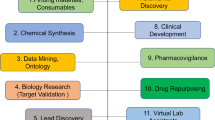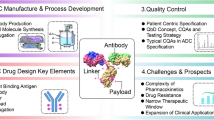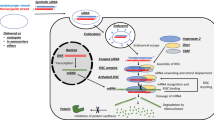Abstract
Background
Understanding the mechanisms, activated and inhibited pathways as well as other molecular targets involved in existing and emerging disease conditions provides useful insights into their proper diagnosis and treatment and aids drug discovery, development and production. G protein-coupled receptors (GPCRs) are one of the most important classes of targets for small-molecule drug discovery. Of all drug targets, GPCRs are the most studied, undoubtedly because of their pharmacological tractability and role in the pathophysiology as well as the pathogenesis of human diseases.
Main body of the abstract
GPCRs are regarded as the largest target class of the “druggable genome” representing approximately 19% of the currently available drug targets. They have long played a prominent role in drug discovery, such that as of this writing, 481 drugs (about 34% of all FDA-approved drugs) act on GPCRs. More than 320 therapeutic agents are currently under clinical trials, of which a significant percentage targets novel GPCRs. GPCRs are implicated in a wide variety of diseases including CNS disorders, inflammatory diseases such as rheumatoid arthritis and Crohn’s disease, as well as metabolic disease and cancer. The non-olfactory human GPCRs yet to be clinically explored or tried are endowed with perhaps a huge untapped potential drug discovery especially in the field of immunology and genetics.
Short conclusion
This review discusses the recent advances in the molecular pharmacology and future opportunities for targeting GPCRs with a view to drug development.
Similar content being viewed by others
Background
Since medicine is an ever changing field, newer technologies when applied change our understanding and it is imperative that existing knowledge be updated. It is on this premise that this article is conceived. This review aims to provide an update on the receptor pharmacology, highlighting the untapped drug discovery potentials of the G protein-coupled receptors (GPCRs). It considers and prioritizes recently (within the last decade) published articles on the advances on the structural biology of the human GPCRs as well as the application of different biotechnological approaches focusing on GPCRs as drug targets. These include recently introduced molecular docking algorithms, protein modelling, biased agonism and application of bioinformatics in computer-aided drug design. The review brings to fore the emerging trend and future therapeutic potentials of the orphan GPCRs.
Main text
G protein-coupled receptors (Fig. 1) are the most studied membrane receptors in humans as well as numerous other species [1]. As reported by Oprea and colleagues [2], there are more than 800 human GPCRs of which more than 400 are non-olfactory. They are not surprisingly the largest family of membrane receptors utilized as drug targets both for approved and novel drugs alike [3]. This is chiefly because of their ability to regulate numerous and diverse physiological processes [4] including regulation of appetite, taste, smell, inflammation amongst others. Additionally, GPCRs are endowed with immense druggable sites that are easily accessed by xenobiotics at the cell surface. Within the last two decades, there have been significant insights and understanding of G protein-coupled receptors [5]. Distortion in the signalling pathways or mutations in GPCRs have also been implicated in many diseases [6]. According to Hauser et al. [4], “recent advances in receptor pharmacology, breakthroughs in structural biology and innovations in biotechnology” have all potentiated newer avenues for GPCR drug discovery. Currently, numerous diseases involving the endocrine, cardiovascular, neural and immune systems have been effectively treated or managed through the pharmacological modulation of the GPCRs.
Characteristic features of GPCRs
The G protein-coupled receptors are a large family of integral membrane proteins with seven transmembrane helices. Based on evolutionary homology the GPCR superfamily has been divided into classes and families [7]. The GRAFS classification has five families namely: glutamate, rhodopsin, adhesion, frizzled and secretin [8]. The GPCRs are characterized by amino- or N-terminal domain linked to 7 α-helical transmembrane domains (TMDs) and carboxyl or C-terminal domain. The N-terminal segment and C-terminal segment are, respectively, located in the extracellular and intracellular spaces. When stimulated, an extracellular signal induces receptor conformational changes transmitting such signal to the cell interior and then to the intracellular messengers (G proteins, etc.) [9], arrestins [10] and others [11]. The transmembrane helical bundle (particularly the 3rd, 5th, 6th and 7th) are rearranged during receptor activation [12]. GPCRs interact with various intracellular partners including endogenous peptidergic ligands that trigger the downstream signalling cascade. These feats make them super promising category of drug targets to investigate [13].
GPCRs as targets for computer-aided drug design
Molecular docking is a procedure often used in computer-aided drug design (CADD). Usually, it is applied at different stages of CADD so as to: “(1) predict the binding mode of already known ligands, (2) identify novel and potent ligands and (3) as a binding affinity predictive tool” [14]. Molecular docking is performed using a number of algorithms such as AutoDock [15], AutoDock Vina [16], Glide [17], GOLD [18], amongst others. This field has witnessed a number of improvements and innovative applications such that molecular dynamics is now used as a docking tool [19]. Protein–protein docking has become an even more established method for predicting GPCR dimers. These innovative developments and improvements allow more sophisticated in silico studies with better understanding of the mechanisms involved as an outcome.
Recently introduced GPCR docking algorithms
Novel methods are usually ranked during dock competitions. As such, the CSAR 2014 Exercise included GPCR docking to a number of X-ray structures [20]. As reported by earlier studies [21, 22], recent breakthroughs such as X-ray crystallography and cryo-electron microscopy (cryo-EM) have been very pivotal to the determination of more than ten GPCR–G protein complex structures. However, many of the novel algorithms are yet to be ranked in any competition. One of such recently released algorithms though not tested on GPCRs is Yada [23]. It is a genetic algorithm designed to perform well in blind docking. Without a doubt, these new algorithms improve the quality of peptide docking.
Bioinformatics of GPCR–G protein interactions
In recent years, better insight into the sequences, structures and signalling networks of GPCRs and G proteins is in the public domain. Useful bioinformatics and software tools for exploring GPCR–G protein interactions are available (Table 1). These include the protein data bank (PDB), the GPCRdb, gpDB and human gpDB. For instance, the GPCRdb database houses essential details about the structures, known mutations, homologues, ligands as well as phylogenetic relationships of GPCRs. Also, it identifies ligand binding sites as well as generates GPCR models for virtual screening. This explains why GPCRdb is widely used for studying GPCRs. Certainly, the systematic analysis of data from the GPCRdb could give further insight into GPCRs and the interactions with their endogenous ligands (G proteins).
Antibodies as GPCR therapeutics
Prior to now, GPCRs were not drug targets for antibodies. This is so because GPCRs are predominantly targeted by small molecules. Additionally, the unique pharmacokinetic and pharmacodynamic profiles of antibodies made them compelling alternatives to small-molecule drugs. For instance, they do not readily gain entrance into the central nervous system, allowing for selective targeting of peripheral receptors. However, this has changed as current trends in drug discovery now produces therapeutic antibodies that targets GPCRs with large substrate-binding extracellular domains, with the extracellular domains functioning as binding site for the antibody [1]. The role of GPCRs in diverse physiological and pathophysiological processes has aided the identification of therapeutic areas in which GPCRs could be exploited as suitable as targets for antibody-based drugs (Fig. 2). Out of the more than 400 non-olfactory GPCRs, 88 have been strongly implicated in disease pathogenesis and as suitable targets for therapeutic antibodies.
Biased agonism in the GPCR
This is a ligand-based signalling approach that is seen when multiple signal pathways coexist in a signalling process. From its inception in the field of biological science, the study of biased agonism focuses on the GPCRs, particularly the G protein and β-arrestin classical signal pathways [24] (Fig. 3).
Conventionally, if a receptor- and/or ligand-activated molecule has the inherent ability of interacting with multiple downstream endogenous ligand [25] but directs the downstream signal based on biased ligand binding, only then is the concept of biased agonism applicable to such signalling pathways (Fig. 4). Using biased ligand agonism, many GPCRs-targeted drugs have been developed exploiting the templates provided by the crystal structures of 43 unique receptors and 196 ligand complexes [26].
Emerging trends and therapeutic opportunities for orphan GPCRs
It has been estimated that more than half of the non-olfactory GPCRs encoded for the human genome have not been exploited as drug targets. Orphan GPCRs are GPCRs that were identified through their sequence but currently do not have an identified ligand. Efforts to identify the natural ligands for these orphan receptors are without certain success. However, these receptors are potential drug targets and have been linked to many pathological conditions including metabolic disorders, inflammation, psychiatric disorders and cancers amongst others [4]. Development of therapeutic and functional antibodies should exploit these orphan receptors as such can provide useful insight into their role in pharmacotherapy of various diseases. In the field of metabolic disorder, especially diabetes and obesity, new GPCR-targeted drugs exploit the cell specificity of receptor expression to achieve activation of pancreatic beta cells, gut endocrine cells and neurons involved in the suppression of appetite. These drugs trick the body giving a false-positive response as though food was just consumed, thus stimulating the secretion of glucose-dependent insulin with a resultant inhibition of the hunger centres. The incretin receptors (GLP1R, GIPR) and bile acid receptor (GPBAR1) are amongst the widely exploited GPCRs in drug therapy for diabetes [27].
Conclusions
The G protein-coupled receptors are the extensively studied family of drug targets. These receptors interact selectively with various endogenous partners with different downstream signalling and pharmacological effects as an outcome. The recent advances in computational simulations and software have not only deepen our understanding of the GPCR activation process as well as specificity and tractability, but have overhaul structure-based drug discovery, and as a result, numerous GPCRs are now in clinical trials with interesting and promising outcomes.
Availability of data and materials
Datasets for the study will be made available upon a reasonable written request to the corresponding author.
Abbreviations
- CADD:
-
Computer-aided drug design
- CNS:
-
Central nervous system
- cryo-EM:
-
Cryo-electron microscopy
- DNO:
-
Daniel Nkereuwem Obot
- GPCRs:
-
G protein-coupled receptors
- GRAFS:
-
Glutamate, rhodopsin, adhesion, frizzled and secretin
- PDB:
-
Protein data bank
- TMDs:
-
Transmembrane domains
- GJU:
-
Godswill James Udom
References
Hutchings CJ (2020) A review of antibody-based therapeutics targeting G protein-coupled receptors: an update. Expert Opin Biol Ther 20:925–935. https://doi.org/10.1080/14712598.2020.1745770
Oprea TI, Bologa CG, Brunak S, Campbell A, Gan GN, Gaulton A, Gomez SM, Guha R, Hersey A, Holmes J, Jadhav A, Jensen LJ, Johnson GL, Karlson A, Leach AR, Ma’ayan A, Malovannaya A, Mani S, Mathias SL, McManus MT, Meehan TF, von Mering C, Muthas D, Nguyen DT, Overington JP, Papadatos G, Qin J, Reich C, Roth BL, Schürer SC, Simeonov A, Sklar LA, Southall N, Tomita S, Tudose I, Ursu O, Vidovic D, Waller A, Westergaard D, Yang JJ, Zahoránszky-Köhalmi G (2018) Unexplored therapeutic opportunities in the human genome. Nat Rev Drug Discov 17(5):317–332
Santos R, Ursu O, Gaulton A, Bento AP, Donadi RS, Bologa CG, Karlsson A, Al-Lazikani B, Hersey A, Oprea TI, Overington JP (2017) A comprehensive map of molecular drug targets. Nat Rev Drug Discov 16(1):19–34. https://doi.org/10.1038/nrd.2016.230
Hauser AS, Attwood MM, Rask-Andersen M, Schioth HB, Gloriam DE (2017) Trends in GPCR drug discovery: new agents, targets and indications. Nat Rev Drug Discov 16(12):829–842. https://doi.org/10.1038/nrd.2017.178
Latek D, Modzelewska A, Trzaskowski B, Palczewski K, Filipek S (2012) G protein-coupled receptors—recent advances. Acta Biochim Pol 59(4):515–529
Thompson AA, Liu W, Chun E, Katritch V, Wu H, Vardy E, Huang XP, Trapella C, Guerrini R, Calo G, Roth BL, Cherezov V, Stevens RC (2012) Structure of the nociceptin/orphanin FQ receptor in complex with a peptide mimetic. Nature 485(7398):395–399. https://doi.org/10.1038/nature11085
Bondarev AD, Attwood MM, Jonsson J, Chubarev VN, Tarasov VV, Schiöth HB (2020) Opportunities and challenges for drug discovery in modulating Adhesion G protein-coupled receptor (GPCR) functions. Expert Opin Drug Discov 15(11):1291–1307. https://doi.org/10.1080/17460441.2020.1791075
Fredriksson R, Lagerström MC, Lundin LG, Schiöth HB (2003) The G-protein-coupled receptors in the human genome form five main families. Phylogenetic analysis, paralogon groups, and fingerprints. Mol Pharmacol 63(6):1256–1272. https://doi.org/10.1124/mol.63.6.1256
Gomperts BD, Kramer I, Tatham PER (2009) GTP-binding proteins and signal transduction. In: Gomperts BD, Kramer IM, Tatham PER (eds) Signal transduction, 2 edn, vol 2. Academic Press, San Diego, pp 81–129. https://doi.org/10.1016/B978-0-12-369441.00004-0
Rankovic Z, Brust TF, Bohn LM (2016) Biased agonism: an emerging paradigm in GPCR drug discovery. Bioorg Med Chem Lett 26(2):241–250. https://doi.org/10.1016/j.bmcl.2015.12.024
Walther C, Ferguson SS (2015) Minireview: Role of intracellular scaffolding proteins in the regulation of endocrine G protein-coupled receptor signaling. Mol Endocrinol 29(6):814–830. https://doi.org/10.1210/me.2015-1091
Altenbach C, Kusnetzow AK, Ernst OP, Hofmann KP, Hubbell WL (2008) High-resolution distance mapping in rhodopsin reveals the pattern of helix movement due to activation. Proc Natl Acad Sci 105:7439–7444. https://doi.org/10.1073/pnas.0802515105
Vass M, Kooistra AJ, Yang D, Stevens RC, Wang MW, de Graaf C (2018) Chemical diversity in the G protein-coupled receptor superfamily. Trends Pharmacol Sci 39(5):494–512. https://doi.org/10.1016/j.tips.2018.02.004
Bartuzi D, Kaczor AA, Targowska-Duda KM, Matosiuk D (2017) Recent advances and applications of molecular docking to G protein-coupled receptors. Molecules 22(2):340. https://doi.org/10.3390/molecules22020340
Morris GM, Goodsell DS, Halliday RS, Huey R, Hart WE, Belew RK, Olson AJ (1998) Automated docking using a Lamarckian genetic algorithm and an empirical binding free energy function. J Comput Chem. https://doi.org/10.1002/(SICI)1096-987X(19981115)19:14%3c1639::AID-JCC10%3e3.0.CO;2-B
Trott O, Olson AJ (2010) AutoDock Vina: improving the speed and accuracy of docking with a new scoring function, efficient optimization, and multithreading. J Comput Chem 31(2):455–461. https://doi.org/10.1002/jcc.21334
Verdonk ML, Cole JC, Hartshorn MJ, Murray CW, Taylor RD (2003) Improved protein-ligand docking using GOLD. Proteins 52(4):609–623. https://doi.org/10.1002/prot.10465
Vuong QV, Nguyen TT, Li MS (2015) A new method for navigating optimal direction for pulling ligand from binding pocket: application to ranking binding affinity by steered molecular dynamics. J Chem Inf Model 55(12):2731–2738. https://doi.org/10.1021/acs.jcim.5b00386
Carlson HA, Smith RD, Damm-Ganamet KL, Stuckey JA, Ahmed A, Convery MA, Somers DO, Kranz M, Elkins PA, Cui G, Peishoff CE, Lambert MH, Dunbar JB Jr (2016) CSAR 2014: a benchmark exercise using unpublished data from Pharma. J Chem Inf Model 56(6):1063–1077. https://doi.org/10.1021/acs.jcim.5b00523
Yan F, Bikbulatov RV, Mocanu V, Dicheva N, Parker CE, Wetsel WC, Mosier PD, Westkaemper RB, Allen JA, Zjawiony JK, Roth BL (2009) Structure-based design, synthesis, and biochemical and pharmacological characterization of novel salvinorin analogues as active state probes of the kappa-opioid receptor. Biochemistry 48(29):6898–6908. https://doi.org/10.1021/bi900605n
Ben-Shimon A, Niv MY (2015) AnchorDock: blind and flexible anchor-driven peptide docking. Structure 23(5):929–940. https://doi.org/10.1016/j.str.2015.03.010
Yan C, Xu X, Zou X (2016) Fully blind docking at the atomic level for protein–peptide complex structure prediction. Structure 24(10):1842–1853. https://doi.org/10.1016/j.str.2016.07.021
Piotto S, Di Biasi L, Fino R, Parisi R, Sessa L, Concilio S (2016) Yada: a novel tool for molecular docking calculations. J Comput Aided Mol Des 30(9):753–759. https://doi.org/10.1007/s10822-016-9953-9
Wei H, Ahn S, Shenoy SK, Karnik SS, Hunyady L, Luttrell LM, Lefkowitz RJ (2003) Independent beta-arrestin 2 and G protein-mediated pathways for angiotensin II activation of extracellular signal-regulated kinases 1 and 2. Proc Natl Acad Sci 100(19):10782–10787. https://doi.org/10.1073/pnas.1834556100
Michel MC, Seifert R, Bond RA (2014) Dynamic bias and its implications for GPCR drug discovery. Nat Rev Drug Discov 13(11):869. https://doi.org/10.1038/nrd3954-c3
Skiba MA, Kruse AC (2021) Autoantibodies as endogenous modulators of GPCR signaling. Trends Pharmacol Sci 42(3):135–150. https://doi.org/10.1016/j.tips.2020.11.013
Reimann F, Gribble FM (2016) G protein-coupled receptors as new therapeutic targets for type 2 diabetes. Diabetologia 59(2):229–233. https://doi.org/10.1007/s00125-015-3825-z
Acknowledgements
GJU appreciates the tenacity and doggedness demonstrated by all the authors during the course of this work.
Funding
The study received no funding from any external body.
Author information
Authors and Affiliations
Contributions
This work was carried out in collaboration between all authors. Authors DNO and GJU conceived and planned the work. GJU prepared the article. All authors equally contributed to the vetting process and made significant financial contributions. All authors read and approved the final manuscript.
Corresponding author
Ethics declarations
Ethical approval and consent to participate
Not applicable.
Consent for publication
Not applicable.
Competing interests
The authors have declared that no competing interests exist.
Additional information
Publisher's Note
Springer Nature remains neutral with regard to jurisdictional claims in published maps and institutional affiliations.
Rights and permissions
Open Access This article is licensed under a Creative Commons Attribution 4.0 International License, which permits use, sharing, adaptation, distribution and reproduction in any medium or format, as long as you give appropriate credit to the original author(s) and the source, provide a link to the Creative Commons licence, and indicate if changes were made. The images or other third party material in this article are included in the article's Creative Commons licence, unless indicated otherwise in a credit line to the material. If material is not included in the article's Creative Commons licence and your intended use is not permitted by statutory regulation or exceeds the permitted use, you will need to obtain permission directly from the copyright holder. To view a copy of this licence, visit http://creativecommons.org/licenses/by/4.0/.
About this article
Cite this article
Obot, D.N., Udom, G.J., Udoh, A.E. et al. Advances in the molecular understanding of G protein-coupled receptors and their future therapeutic opportunities. Futur J Pharm Sci 7, 194 (2021). https://doi.org/10.1186/s43094-021-00341-0
Received:
Accepted:
Published:
DOI: https://doi.org/10.1186/s43094-021-00341-0








